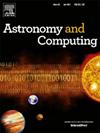一种数据驱动的系外行星大气特征提取方法
IF 1.8
4区 物理与天体物理
Q2 ASTRONOMY & ASTROPHYSICS
引用次数: 0
摘要
基于地面的高分辨率透射光谱已经成为探测凌日系外行星大气化学成分的关键工具。在这个范围内,一个众所周知的挑战在于去趋势过程,这包括有效地去除污染的恒星和大地吸收特征,使行星光谱模糊不清。主成分分析(PCA)是目前最先进的方法,但其有效性取决于选择正确数量的成分——这是一个主观的选择,会影响到多少行星信号被保留或丢失,而要去除的特征是由主成分的线性组合很好地表示出来的。此外,没有定量的框架来区分残差从不完全减法和那些包含真正的行星信号。在这项工作中,我们引入了一种新颖的,计算机视觉启发的方法来完成使用深度卷积生成对抗网络(dcgan)的去趋势任务,结合语义图像绘制,能够克服PCA的局限性。与PCA相比,我们提出的去趋势方法以非线性方式运行,允许从干扰信号中可扩展和稳健地分离行星大气特征,并消除对手动选择主成分的依赖。作为一个案例研究,我们考虑了伽利略国家望远镜上的HARPS-N光谱仪获得的超热木星KELT-9 b的观测结果。虽然需要进一步的改进才能与PCA完全竞争,但我们的方法成功地产生了真实的无交通夜晚和有希望的残差,为未来机器学习驱动的趋势方法铺平了道路。本文章由计算机程序翻译,如有差异,请以英文原文为准。
A data-driven approach for extracting exoplanetary atmospheric features
Ground-based high-resolution transmission spectroscopy has become a critical tool for probing the chemical compositions of transiting exoplanetary atmospheres. A well-known challenge in this scope lies in the detrending process, which consists in effectively removing contaminating stellar and telluric absorption features obscuring the planetary spectrum. Principal Component Analysis (PCA) is the current state-of-the-art method, but its effectiveness depends on selecting the correct number of components—a subjective choice that impacts how much of the planetary signal is preserved or lost, and the features to be removed are well represented by the linear combination of the principal components. Additionally, there is no quantitative framework for distinguishing between residuals from incomplete subtraction and those containing the true planetary signal.
In this work, we introduce a novel, computer vision-inspired approach to the task of detrending using Deep Convolutional Generative Adversarial Networks (DCGANs), combined with semantic image inpainting, able to overcome the limitations of PCA. In contrast to PCA, our proposed detrending method operates in a non-linear fashion, allowing for a scalable and robust separation of planetary atmospheric features from interfering signals and eliminating reliance on the manual selection of principal components. As a case study, we consider observations of the ultra-hot Jupiter KELT-9 b acquired by the HARPS-N spectrograph at the Telescopio Nazionale Galileo. Although further refinement is needed for full competitiveness with PCA, our method successfully produces realistic transit-free nights and promising residuals, paving the way for future machine learning-driven detrending methods.
求助全文
通过发布文献求助,成功后即可免费获取论文全文。
去求助
来源期刊

Astronomy and Computing
ASTRONOMY & ASTROPHYSICSCOMPUTER SCIENCE,-COMPUTER SCIENCE, INTERDISCIPLINARY APPLICATIONS
CiteScore
4.10
自引率
8.00%
发文量
67
期刊介绍:
Astronomy and Computing is a peer-reviewed journal that focuses on the broad area between astronomy, computer science and information technology. The journal aims to publish the work of scientists and (software) engineers in all aspects of astronomical computing, including the collection, analysis, reduction, visualisation, preservation and dissemination of data, and the development of astronomical software and simulations. The journal covers applications for academic computer science techniques to astronomy, as well as novel applications of information technologies within astronomy.
 求助内容:
求助内容: 应助结果提醒方式:
应助结果提醒方式:


